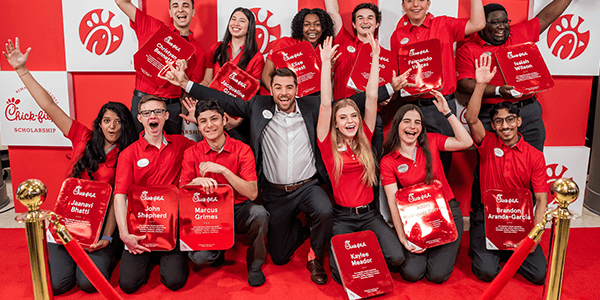

The Connections that Keep Students on Track
Enrollment recovery isn’t happening steadily or evenly. Instead, while cohorts are getting back to school in pre-pandemic numbers, others are still struggling.
Filed In
- Beyond the Scholarship
Topics
- Enrollment
For the first time since the outbreak of COVID-19 threw the world of higher education into disarray, college enrollment is stabilizing.
According to the latest data from the National Student Clearinghouse, “Undergraduate enrollment continued to shrink this fall but the decline has slowed to nearly pre-pandemic rates.” Community college enrollment was nearly steady year-over-year, and, despite the overall decline, some universities are even reporting record class sizes.
However, the enrollment recovery isn’t happening steadily or evenly. Instead, while cohorts are getting back to school in pre-pandemic numbers, others are still struggling. As covered in Inside Higher Ed:
“One particularly troubling enrollment trend exacerbated by the pandemic … is the decline of underrepresented groups—specifically Black, first-generation and low-income students.
“These groups that have more tenuous connections to higher ed are exactly the groups you would hope to penetrate more if your response to declining demographics were to increase access … and yet, these are the groups who stepped away during the pandemic,” [Terry Hartle, senior vice president of government relations and public affairs at the American Council on Education] said. “Seeing whether those groups come back in force is going to be really important as we look forward and think about the work that needs to be done.”
To ensure these historically underserved and underrepresented groups get back to their educational pathways, financial help and formal guidance are important. But as they navigate the tricky path from aspirations to success, it’s just as important to provide and foster these three types of connections. By doing so, we can help assure students that they’re not alone, and that they can succeed in a post-COVID college landscape.
Connecting students with those who understand their unique circumstances
One of the biggest difference-makers for students from traditionally underrepresented backgrounds as they pursue college is simply finding others who understand where they come from and how they see the world. College is a big change for anyone, and it’s even more daunting for rural students in large cities; Black students at majority-white colleges; or students from low-income families suddenly in the midst of wealthier peers.
Students from traditional college-going backgrounds and multi-generation college families enter higher education with informal networks of family, friends and peers in place to help them navigate the landscape—but for many others, it can feel like embarking on a journey entirely alone.
And that’s true throughout their college career: first-gen college seniors are 10-13% less likely to have discussed their career goals with faculty; interviewed or shadowed someone in their field or done any professional networking (according to the 2021 NSSE Career & Workforce Preparation Module). Across the board, all students of color were 3-5% less likely to have done so, irrespective of any other characteristics.
To help fill that gap, colleges, communities and scholarship providers are in a unique position to step in. On an institutional level, there are initiatives like DavisConnects at Maine’s Colby College, a partnership with the campus career center that “guarantees every student at least one internship, research opportunity, or global experience regardless of personal and financial networks.”
Community-based initiatives can be geographical (as we’ll get into below); as nontraditional and online students make up a greater percentage of the college population, they can also be digital solutions like the app Upswing, a virtual student service center and peer-to-peer connector for remote students; as app founder Melvin Hines Jr. (the son of two working students himself) told the Chronicle, “’Nontraditional students don’t get access to the same resources that everyone else does,’ even though they’re usually paying the same tuition.”

Finally, scholarship providers are in a unique position to help students develop peer networks among their fellow recipients. The Chick-fil-A Scholars Program, for example, brings together students from multiple Chick-fil-A programs for a year-long mentoring and leadership development experience; and the Amazon Future Engineer program provides scholarships, internships and an instant professional network to its 400 recipients each year. (You don’t have to be a Fortune 500 company, either—community organizations like our Detroit Regional Dollars for Scholars affiliate work from 10th grade through college graduation to build and maintain student and alumni peer networks!)
Growing local, community and student-led networks
Of course, while institutionally led connections can be important, no one understands the struggles of college students better than others in their campus community—and that’s why local and student-led connections are an essential part of college success.
Those connections can provide students with the first and fastest line of defense when their basic needs are at risk. Across the country, informal student-led mutual aid networks are providing peers with a fast, easy way to help each other through tough financial times; more formally, efforts include:
- Campus food pantries in California coordinated by CalFresh, the state’s food assistance program.
- Schools and alumni groups stepping up to provide housing for students who can’t find an affordable option, particularly during winter and summer breaks.
- Colleges providing wifi and secure overnight parking for commuter students who may not have workspace, dedicated broadband or a safe situation at home.
- Institutional and outside emergency grants, to help when students face sudden and unexpected financial setbacks.

In addition to these tangible supports, peer-focused and student-led networks can also help with academic and mental health challenges—especially when colleges’ counseling and advising departments are overwhelmed. As EdSurge reported in this thorough overview of peer-to-peer services,
“As some colleges turn to chatbots and online portals stocked with information when staff-to-student ratios for services get too high, leaders should keep in mind that such approaches can optimize for conveying information at the expense of nurturing students’ networks.
“Peer-to-peer models, on the other hand, can achieve scale rapidly because of the value of a human relationship and the sheer number of peers (rather than staff) available to help one another.”
Whether it’s face-to-face, text-or-chat-based or using a platform like the anonymous Unmasked, these connections offer students somewhere to turn and someone to listen—and that can make all the difference at the right time.
Helping students who don’t know what they don’t know
In Scholarship America’s annual survey of college students, we heard once again how important both public and private-sector financial assistance can be. But when the Gates Foundation interviewed adults 18-30 who didn’t finish a degree, they found that the knowledge gap was also a major factor: around ¾ of respondents said that being connected to a job counselor, financial aid advisor or academic counselor would be extremely or very helpful to going back and finishing college.
In short, money is important—but making sure students know there’s money is equally important.
That’s why we put together this list of who’s who on campus, and it’s why schools who have successfully increased low-income and first-generation enrollment have relied on specific, targeted outreach. As profiled in the Chronicle of Higher Education:
Beyond the money itself, conveying to students that there’s financial support to enroll can make a big difference. [The University of Illinois at] Urbana-Champaign does that explicitly with its Illinois Commitment, proclaiming its promise of “Four Years. Free Tuition” to all in-state students from families with incomes under $67,000. …The Colby Commitment, which promises to meet 100 percent of low-income students’ costs without requiring loans, sends a similar message. The students are expected to pay only $1,800 a year by working a campus job and contributing at least $1,650 from summer earnings. For those with family incomes above $65,000, there’s a user-friendly college-cost calculator that generates estimates based on students’ answers to six basic financial questions, available in English and Spanish.
Proactive outreach and pre-emptive answers to students’ most pressing questions have helped these schools—as well as the University of Texas at Austin, which announced its largest ever freshman class and reached an all-time high in enrollment of historically underrepresented students this year. One third of the university’s undergraduate population is Black, Hispanic, American Indian or Alaska Native or Native Hawaiian or other Pacific Islander. And that’s not by accident.
“We are committed to recruiting talented students with diverse backgrounds and experiences,” said [UT Austin President Jay] Hartzell. “The gains we have made are a testament to this effort, as well as our campaign pledge to raise $1 billion for scholarships and student support programs that will continue to expand opportunities for Longhorns from traditionally underserved communities.”
The journey to a college degree or certification is a tough one, and no student can complete it alone—especially if they don’t have family or friends with higher-education experience to turn to. By building these important safety nets and connections, all of us can help remove barriers and keep every student on track.
Related Articles
Browse All

Using Scholarships to Battle Decreasing Enrollment

Featured Scholarships: December 2025

Our team is here to help you achieve your goals and build your custom scholarship program.